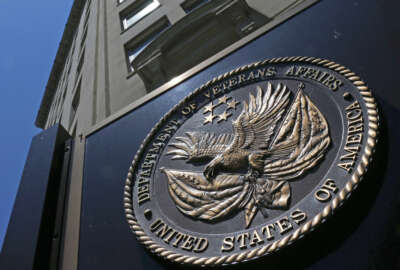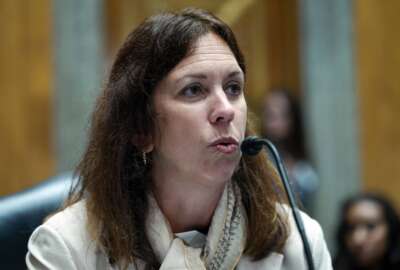

The Veterans Affairs Department is making progress on an effort to digitize military service records for veterans, as part of its implementation of a major VA...
The Veterans Affairs Department is making progress on an effort to digitize military service records for veterans, as part of its implementation of a major VA health care bill signed into law this summer.
VA Secretary Denis McDonough, speaking Wednesday at a town hall event at the Washington, D.C. VA medical center, said the agency is in the process of storing digitized service records in the cloud, and developing automated decision tools to fast-track veterans’ access to care.
“When you make a claim, for example, we can go prosecute those records using automated decision support tools, rather than requiring somebody to leaf through them page by page,” McDonough said. “So leaving to the machines what the machines do well, which is go through a lot of data quickly, to pull out of the relevant pieces, and then leaving to humans — our great VBA workforce — to do what they do well, which is to make a judgment about that analytic information.”
McDonough said the agency’s priority of digitizing service records dates back to the early 2010s.
“This reliance on paper was buckling the floor up in the VA regional office in Baltimore, and was impossible to timely review those records. So we are going through the process of digitizing them,” he said.
VA Press Secretary Terrence Hayes told Federal News Network in September, following a monthly press conference, that VA’s Office of Automated Benefit Delivery (ABD) is accelerating the process for digitizing service member and veteran records used to determine eligibility for VA benefits.
Working with the National Archives and Records Administration, ABD is proactively scanning military records for veterans who may file an initial claim for benefits under the recently passed PACT Act.
Hayes said the VA expects to complete this digitization project in the second quarter of fiscal 2023. As of Sept. 28, ABD has digitized about 38% of the 170,000 Pact Act files it has received so far.
“By storing these documents in our VA claims systems, these records are available to our claims processors on the same day as the corresponding veteran’s claim is received,” Hayes said.
Acting Under Secretary for Benefits Josh Jacobs told reporters on Sept. 28 that the COVID-19 pandemic limited the VA’s ability to obtain military service records from NARA’s National Personnel Records Center in St. Louis, Missouri, where military and medical records are stored.
“What we’re trying to do, and we’ve been doing for some time, is to try to scan every single military record we can so we can anticipate the potential issues, like we’ve just experienced over the last couple of years. So rather than having to go to our colleagues at NARA and make a request to physically pull out records, scan them, and send them over, we have them available at the push of a button,” Jacobs said.
Jacobs added that VA is working with Congress and the appropriations committees on providing funding to continue its digitization efforts.
NARA’s backlog, which reached about 600,000 requests at its peak, has now fallen to about 440,000 requests.
Colleen Shogan, President Biden’s pick to lead NARA, Colleen Shogan, told the Senate Homeland Security and Government Affairs Committee during a Sept. 21 confirmation hearing that said despite the backlog having been “reduced considerably,” the agency still has a long way to go.
The Technology Modernization Fund in May invested $9.1 million in NARA to address the backlog of veterans’ records requests, which are required for veterans to receive medical treatment, unemployment assistance and other benefits from VA.
The investment would go toward creating a cloud-based platform for the records, enabling NARA staff to more quickly and securely deliver veterans’ records requests.
McDonough provided an update on VA’s records digitization effort after taking a question from the town hall audience.
Bill Watkins, a Marine Corps veteran from Virginia, told McDonough that he spent the better part of 15 years trying to acquire his military medical records after losing his hard-copy records.
“I put in a couple of requests and a couple of faxes. It’s probably been the better part of six months,” Watkins said. “The last I’d heard it, maybe it’s going to be put on a CD and somehow shipped to my house. I was talking to my wife. I’m not sure we’ve got a CD player.”
McDonough said the agency would follow up with Watkins directly about his problems retrieving service records.
“It doesn’t make sense to get it in a digital form, if it’s in a digital form that’s not retrievable,” McDonough said.
McDonough said the VA’s ongoing effort to rollout a new Electronic Health Record from Oracle-Cerner would also facilitate the seamless transfer of digital records between the Defense Department and VA.
“That will allow us to access digitally your full record, from your service in the Corps, from the moment you joined, until the moment your care with us is no longer needed,” McDonough said.
The EHR rollout, however, has run into major delays, after the VA’s inspector general’s office reported instances of the EHR contributing to patient harm and decreased quality of care.
The VA is pushing back upcoming deployments of its Oracle-Cerner EHR to June 2023 to address previously known and emerging problems with the system and to “make sure it is functioning optimally for veterans and for VA health care personnel.”
Meanwhile, the VA is sending letters to 41,500 veterans who may have been impacted by problems with the EHR currently running at five VA locations across the U.S.
McDonough said the progress in implementing the new EHR has been “frustratingly slow.”
“That program has been something that we’ve been trying to do in different ways in VA for literally decades. We’re making strides on that,” he said.
McDonough also thanked VA employees, many of whom are veterans themselves, for going above and beyond to deliver care to patients since the start of the COVID-19 pandemic.
“Service never stopped at our VA medical centers, at our CBOCs, among our regional offices, at national cemeteries across the country, during the pandemic. But how we provided service changed,” McDonough said. “What was a constant was our workforce — many of them veterans themselves — performing services, providing care, providing benefits to veterans at an extraordinarily high level, more provision of care to more veterans than at any time in our history over the course of the last two years.”
In response to audience questions about timely access to care, McDonough said the VA is holding a nationwide hiring effort later this month focused on ways to more quickly hire and onboard new employees.
“One of the reasons that we have trouble with timely access to things like blood draw or to primary care physicians, or even to specialists, is that we’re down on staff, meaning we’re short-staffed. Especially after the pandemic, everybody has seen the health care labor market tighten. So we are working super aggressively to backfill those needs.”
The PACT Act gave the VA additional hiring authorities, as well as pay and bonus incentives to keep employees with in-demand skills on the job.
McDonough said the VA ended fiscal 2022 with a net increase of 2,400 VA nurses, but must hire another 45,000 over the next three years to keep up with attrition and demand for VA care.
McDonough said the VA hired more front-line providers in September than at any other point in the VA’s history.
Copyright © 2025 Federal News Network. All rights reserved. This website is not intended for users located within the European Economic Area.
Jory Heckman is a reporter at Federal News Network covering U.S. Postal Service, IRS, big data and technology issues.
Follow @jheckmanWFED



